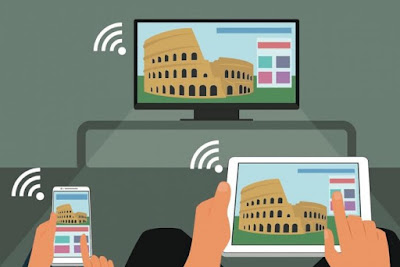What is Screen Mirroring? And how does it work ?
Screen Mirroring in Hindi
Imagine displaying the content of your smartphone, tablet or PC on a large screen with just a few simple steps. You may have heard of screen mirroring, streaming and casting, but there are subtle differences between each of them. In this detailed article, you will find out why screen mirroring is a great solution for classrooms and meeting rooms, as well as the difference between screen mirroring and media streaming.
At its heart, both screen mirroring and media streaming refer to sharing content from a compatible device to a projector or TV, whether it is a smartphone, laptop, PC or tablet. The difference between screen mirroring and media streaming is often overlooked. This question comes to us many times and today the confusion between these two types of technology has to be cleared.
Screen mirroring is a wireless technology that allows you to switch media running on your small Android, Windows or Apple device to a larger screen, for a better viewing experience.
This large device is usually a television or media projector, often installed in your home media or living room. Media that you can mirror, but is not limited to personal photos and slideshows, music, videos, games, and movies, can originate from the Internet or an app like Netflix or YouTub
How Screen Mirroring Works
Working of Screen Mirroring in Hindi - how screen mirroring works
Screen mirroring requires two components: a screen-sending device and a screen-receiving device.
The screen-sending device uses a screen-mirroring protocol. There are several screen-mirroring protocols. Great examples of this include Apple AirPlay on iPhones and Google Cast on Chromebooks.
Screen Mirroring also requires a receiver. The receiver is the destination for the content you are trying to display. There are hardware receivers, such as Apple TV, Chromecast and many more. There are also software applications such as Reflector that turn existing devices - such as Mac or Windows computers - into stronger receivers.
Screen-mirroring connections can be established in several ways depending on the devices trying to connect. The devices are equipped with a variety of screen-mirroring technologies (such as AirPlay and Google Cast) and therefore do not always share the same compatibility. For example, Windows devices are equipped with Miracast while Apple devices use AirPlay. This prevents Windows devices from connecting to Apple TV wirelessly. These technical barriers create problems for businesses and schools that deploy and use multiple device types.
Fortunately, there are third-party screen-mirroring solutions with cross-platform compatibility like Ditto to help narrow that gap..






![How To Get 5000+ Likes On Post In Just Few Minutes [2018]](https://blogger.googleusercontent.com/img/b/R29vZ2xl/AVvXsEi6EwQ5DEOjZV2jnxEszc44gLd6UCTdDnNCFhKzJZhel40l1tirtaegJVx3aNh9bLg8BE9j2UESAnZBa4F6mrFuEusfYimGpGv_BjFc1ZULcShw0FjmiNueUB9hr_TGPaLkePFfxXMS65lt/s72-c/facebook-1497424771021.png)
![अपने ब्लॉग को रैंकिंग के बिना ईवेंट ब्लॉगिंग से पैसा कमाएं [100$+]](https://blogger.googleusercontent.com/img/b/R29vZ2xl/AVvXsEhshNOG9vQQ-pZWwQljkeExxoDA8ZYsZGdgb_a30y1l7RTaeIqx17jjvgeunDNbKWyhWPkWQenKHx5_nLyMYL1NsLuQP8UFEKHLLL-zAW-n3KLyeUWdsjuEv5htdgpAxMvl3IA7ICNzaUxW/s72-c/maxresdefault+%25284%2529.jpg)
No comments: